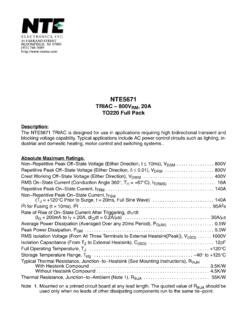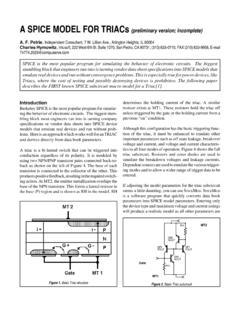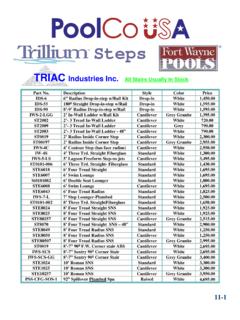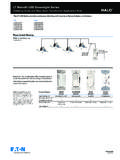Transcription of Phase-Control Alternatives for Single-Phase AC Motors ...
1 Power Systems World 2003 Phase control Alternatives for single Phase AC Motors Page 1 of 8 H. Abramowitz Phase-Control Alternatives for Single-Phase AC Motors Offer Smart, Low-Cost, Solutions by Howard Abramowitz, EE , President, AirCare Automation Inc. Abstract - single Phase AC Motors continue to be the primary solution for air-movement, pumping and compressor applications. Their low cost and availability make them ideal for low-performance systems. DC Brushless platforms attempt to address these applications but their higher cost and complexity continue to form impenetrable barriers of entry. They are viewed as overkill for most applications. Single-Phase Inverter Drives have come on the scene, making headway, but remain complex and costly.
2 Phase-Control solutions are being revisited and upgraded to fill the void. This paper explores the performance limitations and trade-offs of the Phase-Control solution and clarifies the boundaries under which the TRIAC Phase-Control is a preferred method of speed control and the improvements provided by smart Phase-Control . INTRODUCTION Variable speed motor controls have been available for many years. As technology progresses, major innovations and improvements have been made in sophisticated systems improving the motor drive performance and reducing cost and complexity of the available solutions. Thus, improvements in the performance and availability of AC inverter (Inverters) solutions as well as DC brushless drives (BLDC) and Motors have brought these solution options into the market in greater numbers.
3 There are many articles and technical papers that address the improvements and innovations in brushless dc drives as well as improvements in AC drives. What we see little of is the improvements in the existing low-cost control techniques focusing on phase control or other low-cost AC control techniques that don t require the AC power to be converter to twice. This paper revisits the Single-Phase AC motor control and outlines improvements and value added features now available that make Phase-Control drives a viable alternative for speed control in most applications. Of greatest interest is going back to revisit the Phase-Control platform that has been around for many years and look at the innovations and improvements that are available.
4 Comparisons will be made to the Single-Phase inverter designs but we will not directly cover Inverter design innovations here. Most Single-Phase Motors are not designed to work well with high frequency inventers resulting in bearing pitting and motor performance degradation. The results demonstrate that with careful attention to the application requirements and applying state-of-the-art technology to the basic TRIAC topology a good cost-performance solution can be provided that will allow variable speed to be incorporated into numerous applications that were not viable for the manual controlled TRIAC or the expensive Inverter solution. Upgrading the TRIAC control results in smart, performance competitive solutions at a lower cost.
5 Power Systems World 2003 Phase control Alternatives for single Phase AC Motors Page 2 of 8 H. Abramowitz single - PHASE AC MOTOR SPEED CONTROLS The two primary ways to control the speed of a Single-Phase AC motor is to either change the frequency of the line voltage the motor sees or by changing the voltage seen by the motor, thereby changing the rotational speed of the motor. An Inverter will convert the AC waveform into a DC Voltage and them create a PWM signal output that will filter into a waveform with a predetermined voltage (controlling torque) and frequency (controlling speed). Figure 1 has a block diagram of the Inverter design and the various speed waveforms are shown in Figure 2.
6 Key Benefits: Voltage / Frequency control Wide Speed range low-speed / High efficiency Key Drawback: Higher Cost Hi-Voltage Pulses Full Speed losses Motor Reliability Figure 1: Single-Phase AC Inverter Block Diagram Figure 2: AC Waveforms for Inverter Drive The TRIAC, Phase-Control design is simpler. There is a single switch that is in line with the AC line. It chops the AC waveform causing the power to shut off during a portion of the AC Cycle. Figure 3 shows the general schematic for a TRIAC controlled drive. The motor shown is a permanent split capacitor motor having 2 windings and a capacitor for phase shift. AC POWER IN Rectifier BridgeINVERTER STAGE PWM BRIDGE FILTER / LOAD DC HF PWMOUTPUTAC POWER OUT Constant Systems World 2003 Phase control Alternatives for single Phase AC Motors Page 3 of 8 H.
7 Abramowitz Figure 3: AC Chopper / TRIAC control of 1-Phase AC motor The AC motor acts as a low pass filter causing the resulting current waveform to be sinusoidal at the same operating frequency with a slight lag. The lower RMS voltage created by the chopper increases the slip to the motor, thereby reducing motor speed. Essentially starving the motor of its power, the motor slows down and eventually stops because there is not enough energy to maintain rotational speed. Figure 4 shows typical waveforms; the TRIAC driven output and the resulting AC waveform that the motor sees. Figure 4: Phase control AC Waveforms for Single-Phase Motors Key Benefits: Low Cost Ease of control Robust & Reliable Multi-loads Key Drawback: Motor Speed range Lower Efficiency Power Factor Primary Auxiliary AC Input Chopped AC1-PhasePSC Motor Phase control of AC AC V & IAC INPUT (V)Motor VoltageMotor CurrentOriginal AC VoltageChopped AC VoltageAt Motor Resulting Motor Current Power Systems World 2003 Phase control Alternatives for single Phase AC Motors Page 4 of 8 H.
8 Abramowitz TRIAC CONTROLS REVISITED A key problem with TRIAC controls is that the resulting voltage (and ultimately resulting speed) is reduced by essentially starving the motor. However, where very inefficient Motors were the norm years ago, many fan applications are using more efficient and better designed Motors . These Motors can be driven off a Phase-Control scheme down to 30% of motor speed before running out of torque. The motor speed is very sensitive to small changes in the phase angle. Figure 5a depicts the RPM change by phase angle for an efficient fan motor down to 20% speed range. The result is non-linear with minimal speed change as the phase control begins and then enters a steep change mode as the phase angle increases to the heart of the sinusoidal waveform.
9 A well known phenomenon, this characteristic is a frustrating element of existing manual controls as speed changes too fast when using a speed potentiometer. In applications such as clean rooms the constant adjustment and difficulty of setting the speed add much technician time to the set-up and recalibration process. Figure 5a: RPM of motor changes non-linearly with phase angle shift Figure 5b: RPM tracks within 6% of RPM for fan motor over high speed range Figure 5b shows the relationship between the VRMS and RPM of a single phase Motors . Surprisingly, the speed of the fan (RPM) will track with the RMS voltage across the motor. This is impacted by the loading (all the information presented is based upon fan loading).
10 Thus, if a control methodology could be provided that will linearize the RMS Voltage as a function of controller change, the blower speed will likewise be linear. Microprocessor control of the TRIAC drive provides this improvement. The digital control can be designed to match the loading tables of the drive, making the response of the drive to a linear input ( the turning of a speed knob) or the digital input of 0-100% 230 V, 60Hz, 1550 RPM AC Fan Motor 0200400600800100012001400160018000406883 94102 111 121 Phase Angle Cut off (Degrees)Fan Rotation Speed (RPM)RPMVrms & RPM at Phase Angle Control0%20%40%60%80%100%120%21415871819 3104114127134143153166 Phase Angle firingNormalized RPM and VrmsVoltageRPMS teep RPM change Slow RPM change Vrms and RPM track within 6% from 100% to 60% speed range Power Systems World 2003 Phase control Alternatives for single Phase AC Motors Page 5 of 8 H.







